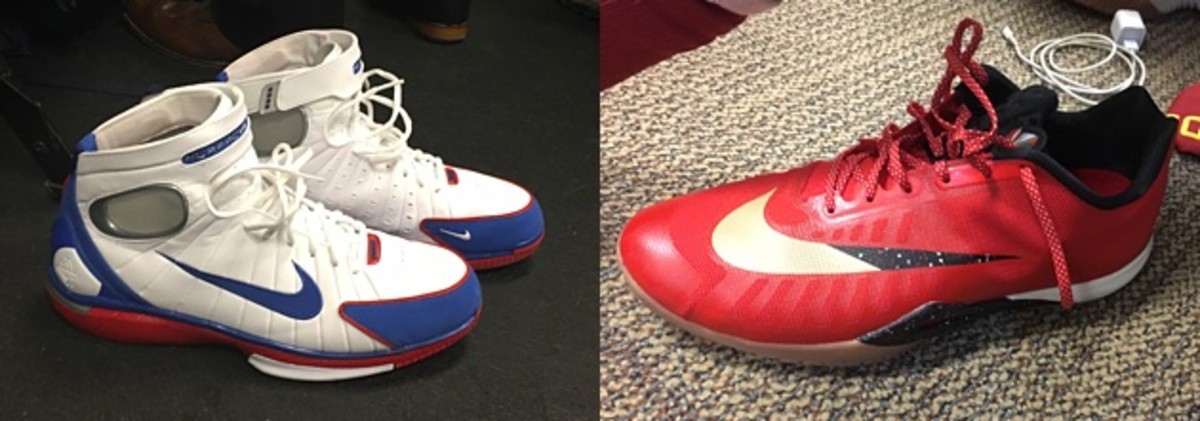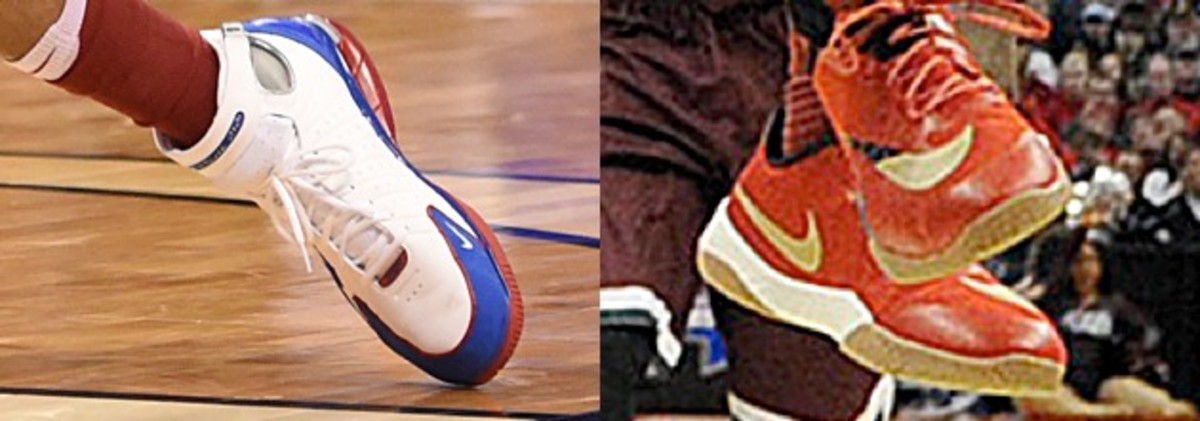Sweet 16 Power Rankings: Which team is most likely to win it all?

Get all of Luke Winn’s columns as soon as they’re published. Download the new Sports Illustrated app (iOS or Android) and personalize your experience by following your favorite teams and SI writers.
Ranking the Sweet 16 in order of most to least likely to win the national championship:
1. Kansas (No. 1 South)
If you still need convincing that Kansas’s defense is national-title caliber, I suggest you re-watch the first half of the Jayhawks’ second-round win against UConn. They held the Huskies to 3-of-20 shooting from inside the arc in that half—and one of those makes was a breakaway layup following a steal. I put screengrabs all 17 of UConn’s interior misses from the first half into the grid below, which shows that 13 (and maybe even 14) were contested by KU defenders:

(Screengrab sources: CBS)
2. North Carolina (No. 1 East)
Quality interior D is generally a hallmark of a national champ: In the kenpom.com era (2002-present), 12 out of 14 champs entered the NCAA tournament ranked in the top 50 in defensive two-point field-goal percentage, the lone outliers being 2007 Florida and 2015 Duke. The median two-point field goal percentage allowed by champs during that stretch is 43.7%, and their median national rank is 24th. Only one 2016 Sweet 16 team checks in below both medians—that would be Kansas—but North Carolina is right behind the Jayhawks:

(Chart data source: kenpom.com)
3. Virginia (No. 1 Midwest)
Will Malcolm Brogdon isolations will become a thing as the Cavaliers move deeper in this NCAA tournament, or were they just exploiting favorable matchups against Butler’s Roosevelt Jones and Andrew Chrabascz in the second round? Brogdon, Virginia’s star senior guard, has averaged 2.3 isolation possessions per game this season, according to Synergy Sports Technology. But against Butler, Brogdon was unleashed for six isos, on which he scored 10 points—or 1.67 points per possession, making it quite the valuable offensive option for Virginia. Here’s a supercut of the is-’hoo-lations:
4. Oklahoma (No. 2 West)
The Buddy Hield-off-the-dribble research that draftexpress.com’s Mike Schmitz Tweeted this week inspired me to take a deeper look at the Bahamanian Bomber’s shooting. Synergy’s halfcourt data from the entire season shows Hield with a nearly even split of off-dribble and off-catch jumpers, and although he’s much improved off the dribble from previous seasons (0.94 PPP as a senior), he’s far more efficient off the catch (1.53 PPP).
When I charted Hield’s small sample of 2016 NCAA tournament shooting—27 jumpers in both halfcourt and transition—the results were much different. The bulk of his jumpers (59.3%) have come off the dribble, and his off-dribble efficiency (1.81 PPP) is well ahead of his off-catch efficiency (0.55 PPP):

And although he’s famous for making threes, Hield is flashing an interior pull-game that’s almost impossible to defend. Here are his two best off-dribble twos from Sunday’s win over VCU:
5. Villanova (No. 2 South)
Only two Sweet 16 teams are more three-point reliant than Oklahoma: Syracuse, which has taken 43.1% of its shots from deep this season, and Villanova, which has taken 43.7%. The Wildcats’ numbers are slightly inflated by heavy early season three-point reliance, though. Their 2015–16 trendline puts them closer to 40%, and they’ve yet to lose a game in which they take less than 40% of their shots as treys:

6. Oregon (No. 1 West)
The SI Extra Newsletter Get the best of Sports Illustrated delivered right to your inbox
Subscribe
The Ducks’ football team had 491 running plays by non-quarterbacks in the 2015 season, and while there’s no way for me (save for many hours of hand-charting) to state this definitively, I think the Ducks’ basketball team may have executed more even more handoffs in 2015–16. They love creating side-to-side motion with a series of handoffs, and even some of their set plays involve handoff actions. The set Oregon ran coming out of halftime against Saint Joseph’s in the tourney’s second round, which consisted of ...
• a Chris Boucher downscreen for Tyler Dorsey
• a pass to Dorsey on the left wing
• a handoff from Dorsey to Casey Benson
• Dorsey running off a Dillon Brooks flare screen to the right wing immediately after the handoff
• Benson passing back to Dorsey
• a Dorsey three-point attempt
... is the Power Rankings’ Play of the Week, even though Dorsey missed the shot:
7. Miami (No. 3 South)
The Hurricanes are in the Sweet 16, in part, because their defense forced Wichita State into its third-highest turnover percentage of the season (23.5%). The Shockers were careful with the ball in their NCAA tournament wins over Vanderbilt and Arizona, but committed 15 turnovers against Miami—a number of them a result of the Hurricanes’ disciplined ballscreen D in halfcourt and transition. Here’s how they created four of the takeaways:
8. Indiana (No. 5 East)
While we’re on the topic of ballscreens and defensive turnover percentage ... Indiana is 6–5 when its defensive TO% is less than 17%, and 21–2 when it’s 17% or higher. In the second round of the NCAAs, the Hoosiers forced takeaways on 22.5% of Kentucky’s possessions and—surprise!—IU pulled off the upset.
The Hoosiers’ work against the Wildcats’ NBA-bound backcourt was particularly impressive. Point guard Tyler Ulis committed four turnovers, all in halfcourt pick-and-roll situations, and all because Indiana had a help defender in a smart position to disrupt the play. Three times that help defender was Troy Williams, whom IU smartly dropped off of non-shooter Isaiah Briscoe and into areas where he could force Ulis to travel or make an ill-advised pass. Shooting guard Jamal Murray committed three turnovers, all of them offensive fouls on which he extended his off arm while driving; Robert Johnson drew one of the charges, while Williams drew two. For a Hoosiers defense that ranked 330th last season in defensive TO%, and is 104th this season, these are promising developments.
9. Iowa State (No. 4 Midwest)
Sneakerheads may have noticed that point guard Monte Morris was among the Cyclones who debuted new kicks for the NCAA tournament: a pair of Nike Air Zoom Huarache 2K4s, a 2016 re-release of a Kobe Bryant All-Star Game shoe from 2004. Morris wore them for the entirety of Iowa State’s first-round win over Iona, and the first half of a second-round win over Little Rock ... but after halftime of that game, he reappeared wearing Paul George’s 2016 All-Star Game kicks instead:


Morris said there was science behind the switch: “My legs were feeling heavy,” he explained, and after 60 minutes of game time in the Denver altitude, he needed a change. “The [Georges] are at least a few ounces lighter.” For a guy who’s played 93.9% of the possible minutes this season, every ounce matters.
10. Duke (No. 4 West)
I’m curious to see if Duke employs its Brandon Ingram-topped 1-3-1 zone to disrupt Oregon’s offense in Anaheim. The Blue Devils switched to it in the final 10 minutes of their second-round win over Yale, and although it messed with the Bulldogs’ offensive flow, it didn’t actually stop them from scoring. I counted 11 halfcourt possessions of 1-3-1, in which Duke yielded 14 points, or 1.27 PPP. The Blue Devils bothered shots, but they gave up four offensive rebounds and committed four fouls in that stretch. Ultimately their (estimated) 51 possessions of halfcourt man and transition D were more efficient, yielding 0.94 PPP.

11. Gonzaga (No. 11 Midwest)
• MORE: The cases for & against every Sweet 16 team
Zags’ forward Domas Sabonis is the best post player left in the tournament—or at least that’s what I argued in a column on Monday—but how will he and frontcourt mate Kyle Wiltjer operate against Syracuse’s 2-3? What they did against Utah’s matchup 2-3 in the second round might offer some clues. My favorite successful Gonzaga play from that game involved putting all three guards on the wings, elevating Sabonis and Wiltjer to the top of the key, and creating an open three for Wiltjer with a 5-4 handoff action:
12. Texas A&M (No. 3 West)
There’s one offensive category in which Aggies co-point guard Alex Caruso has Oklahoma’s backcourt beat: He’s an excellent finisher on short-to-midrange floaters and on shots around the rim. Caruso has made 56.8% of his twos this season, and he’s shot 9-for-13 inside the arc during the NCAA tournament, including an 8-for-11 performance in Sunday’s miracle comeback win over Northern Iowa. The left-driving, right-knee-raised floater he dropped in over the Panthers’ Wyatt Lohaus to send the game to double-overtime was textbook right down to the follow-through:
13. Maryland (No. 5 South)
If the foul-drawing Melo Trimble that we came to know during his freshman season is re-emerging in March 2016, maybe Kansas is in for more of a scare than the 6.5-point Vegas spreads suggest. Trimble has generated 23 free-throw attempts in 65 minutes played in this NCAA tournament, and his tourney ratio of FTAs/FGAs is 0.958—well above the .461 ratio he had over the course of this season, when he appeared to be held back by undisclosed ailments. Trimble’s ‘14–15 ratio was .710, the second-highest for any major-conference freshman.
• MORE: What did we learn in the tourney's opening weekend?
14. Wisconsin (No. 7 East)
Aside from the strangely flatulent audio, this fan-shot, Instagram slo-mo view of Bronson Koenig’s game-winning three against Xavier is absolutely majestic, and even better than the angle captured by TV cameras:
Koenig said we shouldn’t be surprised that he hit that shot; apparently he practices similar versions of it in warmups all the time. He’s also the rare shooter whose guarded catch-and-shoot efficiency, per Synergy, is better than his unguarded efficiency, so this was pretty much his ideal degree of difficulty for a buzzer-beater.
15. Notre Dame (No. 6 East)
The Irish have the fifth-best offense left in the NCAA tournament, but the worst defense by a wide margin. They rank 172nd in adjusted defensive efficiency on kenpom.com, and teams with defenses that porous don’t win national titles. Just one school that ranked outside the top 100 in adjusted D entering the NCAA tournament—2011 VCU, which ranked 145th—has reached the Final Four since these stats began being tracked in 2002. If the peak version of Notre Dame’s offense shows up in Philly, it could make the Final Four, but its D leaves so little room for error against elite competition that it’s difficult to envision the Irish winning six games in a row.
16. Syracuse (No. 10 Midwest)
The Orange’s Friday matchup with Gonzaga features clashing three-point philosophies. Syracuse takes 43.1% of its shots from deep, the second-highest rate among Sweet 16 teams, and the Zags only allow their opponents to take 33.0% of shots from deep—the fourth-lowest rate among Sweet 16 teams. Syracuse’s offense can get so stagnant when it’s not hitting threes that if Gonzaga’s style wins out, the Zags are headed for the Elite Eight.

(Chart data source: kenpom.com)
